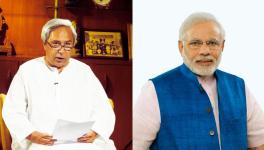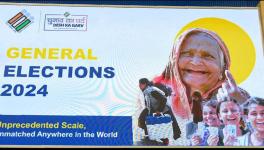Why Tablighi Jamaat is a Red Herring to Conceal Botched Policies
Image use for Representational only. image Courtesy: Deccan Herald
Let us look at the problems created by the Tablighi Jamaat congregation, which ended up complicating the problem of the spread of the Covid-19 disease significantly. At the same time, let us not look at it in isolation, because it turns the spotlight on the way the central government and some state governments have dealt with the crisis at hand.
Let us begin by saying that attempts by elements in the serried ranks of the Hindu right to communalise the issue is as dangerous as it is infantile. The argument that “Muslims” are “responsible” for the reckless spread of the missing is contemptible and misses several points. It would be equally infantile to say that “Hindus” were reckless and unconcerned about the spread of the disease because Uttar Pradesh Chief Minister Adityanath led rituals connected to the shifting of a Ram idol at Ayodhya in the presence of up to 50 people, barely 12 hours after India’s lockdown came into effect.
Let us refrain from going down that road because what is fundamental is the way the government prepared the country for the lockdown and the “battle” against Covid-19. It is that process which exposes the relationship between the ruling elites and the “people”—in other words, the poor and disentitled.
A look at the lockdown or Covid timeline might help set us off. China first reported the disease that came to be known as Covid to the World Health Organization (WHO) on 31 December last year. On 20 January, an American epidemiologist, Dr Eric Feigl-Ding, warned that the disease coming out of China could turn out to be a pandemic. By that time, Wuhan had been locked down. On 30 January, WHO declared a “Public Health Emergency of International Concern”, while designating Covid a pandemic on 11 March.
On 11 January, China recorded the first Covid death. Thailand recorded the first case outside China on 13 January and the Philippines the first death on 2 February. Ten days later, the epicentre, Wuhan, was quarantined. All of Hubei province followed days later. In mid-February, Covid cases started spiking in South Korea, by which time the death toll in China had surpassed that from the 2002-03 SARS epidemic. A Covid outbreak was detected in Iran on 19 February. Two days later, it became obvious that Italy had been badly hit.
By middle to late February, it had become obvious not only that a pandemic was on the loose, as later declared by WHO, but it was being transmitted with preternatural speed. India recorded its first Covid case on 31 January in the shape of a student returning to Kerala from Wuhan. The first few cases were registered in the state, which moved with commendable agility to meet the situation. Unfortunately, as we will see, the central government did not.
The Narendra Modi government had considerable time to prepare. It could have kicked off its preparations right after the news of the first case came in. In other words, at the beginning of February. It didn’t. The cases started piling up on a daily basis from the beginning of March, but there was no transparent reaction from the central government in the public sphere, though individual states started putting measures in place, as the Delhi administration did by banning the assembly of more than 50 people from 16 March. It had on 13 March banned gatherings connected to sporting events.
The first inkling that the central government had started to take matters in hand came as late as the fourth week of March: it first held a symbolic ‘Janata’ curfew on 22 March, which descended into farce; followed it up with a ban on incoming international flights from 23 March; and, finally, at 8:00 pm on 24 March, Prime Minister Narendra Modi announced to a nation panicked into disbelief that the country was going into lockdown midnight onwards. The prime minister had used a bludgeon, when he ought to have used a feather.
The manner of the announcement of the blanket countrywide lockdown, which may or may not have been necessary at that point, was utterly inexplicable. Let me outline another kind of possible progression. The government must have known by the middle of February, by which time South Korea, Iran and Italy had been hit and the Covid phenomenon had been declared a ‘Public Health Emergency of International Concern’, that action would have to be taken. Why did it not start putting in place the machinery for a lockdown or something similar then?
Extensive work clearly had to be done in consultation with the states and Union territories. Discussions could have begun then, leading to the preparation of state-wise plans and an overarching national plan for locking the country down. Several matters would clearly have to be taken into account: first up, medical preparedness to meet the emergency, meaning adequate provision of personal protective equipment for health professionals, face masks for the public, ventilators and, not least, enough space and beds for isolation/quarantine and treatment and personnel to supervise these.
In a brutally-ironic footnote, it emerged on 31 March that the government had sent a planeload of protective medical equipment to Serbia, when health personnel here were soldiering on with inadequate and sometimes sub-standard kits. The question of sequestering ‘hot-spots’, instead of looking for a one size that fits all could also have been federally discussed. Alongside, uninterrupted interstate supply chains would have to be established for essentials—especially food and medicine—through federal consultations.
There should have been clarity about whether the lockdown would work on the basis of a ‘stay-in-place’ principle or whether people who were out on a limb, mainly migrant workers who would not have work and thus the wherewithal to survive, would be allowed to go home in safe conditions – for example, by the deployment of special trains, buses and other forms of transport. We shall return to a special case of people in this connection.
Finally, we come to the question of what we may call entitlements – or the necessities of life. A lockdown, the whole country knows, would involve depriving of their livelihoods a large number of people who depend on their daily earnings. And, impressionistically, I’m not just talking daily wagers, though they are the worst hit. I’m also talking a host of self-employed people (like small shopkeepers, service providers like the friendly neighbourhood guy who presses your clothes, people involved in the passenger transport sector, etc.)
If the whole country knew, the government, the policymakers and the ‘experts’ must have known. Yet, a plan was not prepared well enough in advance to make sure that the government could ‘bail out’ the needy from Day One. As a matter of fact, it was only on the second day of the lockdown that Finance Minister Nirmala Sitharaman ‘unveiled’ a package of Rs. 1.7 lakh crore to, inter alia, ‘take care of the protein requirements of the poor and give money in their hands through direct benefit transfer’.
Let us leave aside the fact that this does not seem to be very ambitious on behalf of the poor as well as the multifarious weaknesses of the schemes that make up the package. One question still stands out. Why was this package not put together well in time and the food and money transferred to those for whom they were meant before the lockdown. As things stand, no one quite knows when starving people will get cash and food and even how long the lockdown will eventually last.
There is also the question of communication. Why was it necessary for the prime minister to spring the lockdown on the nation at 8:00 p.m., leaving them scrambling to get supplies in? The government’s publicity machinery was more than adequate to launch a campaign to inform citizens through the medium of newspapers, television and radio in all relevant languages. A few coughs and an anodyne message on mobiles just evoked amusement or irritation. And why couldn’t the prime minister, home minister, health minister and others perhaps appear in the media to make short lucid presentations, again in relevant languages. Whoever was running communications strategy should be out of a job.
Let me now get to two special cases. When the lockdown was announced, no mention was made of farmers as constituting one of the special categories who could continue working. This would have been absurd under any circumstance (since farming is not exactly an assembly line that can be stopped and started at any time), but with the Rabi harvesting operations approaching this was surreal. A number of issues arose, including the movement of shared combined harvesters, the availability of migrant labour and the fundamental question of being out in the field. I have already referred to the lack of clarity over the rules for migrants and we have all seen how it’s playing out. It was only in response to stated concerns that the government made special exceptions for farming operations. And, on 31 March the Indian Council for Agricultural Research issued an ‘advisory’ about precautions to be taken during the Rabi harvesting and threshing.
On the question of unpreparedness, let me discuss another issue before returning to the case of the Tablighi Jamaat. There was the question about where the people who were uprooted during the Delhi riots were to go. For most of them, a ‘shelter-in-place’ order would have meant staying in an overcrowded relief camp. Many thousands of displaced people were, for instance, staying temporarily in the Eidgah relief camp when the Delhi order was passed, followed by the lockdown. On being told by the Prime Minister to stay at home, those facing displacement from the camp had only one logical question, “What home?” Their homes had been razed to the ground, their belongings systematically looted. Why did neither the Delhi government nor the Centre make provisions for them before ordering their eviction from the camps on 30 March?
It is in the context of this botched, ad hoc ‘lockdown’ that we must see the Tablighi Jamaat problem. I won’t go into details about who wrote to whom, when and what transpired after that. Better stick to the first principles. The congregation spread over several days should not have been there in view of the Delhi government’s 16 March order banning assemblies of any kind involving more than 50 people, followed by another, similar notification and the ensuing lockdown.
The facts are not all that clear. Minimally, still, we can say that those who had arranged the event should have ensured the dispersal of the group soon after 16 March. But what was the Delhi government doing? Whether or not the organisers had been in touch with it, it must have known about the event and the numbers involved. Smack in the middle of Nizamuddin, huh? It was primarily the responsibility of the government to ensure the dispersal of the crowd long before the lockdown, which came just about a week later.
And there is the issue of the Indonesian preachers who had addressed the meeting and apparently gone walkabout infecting a number of people. The government of India had given them visas and at a time when a public health crisis was impending it just did not monitor their movements. At best, the government was criminally negligent, not to mention incompetent. It should have ensured that the preachers confined themselves to the event they had come for. Such conditions can be specified. Likewise, it should just not have allowed Adityanath to break lockdown orders, whatever the religious compulsions.
The problem here is that anything connected to religion is somehow privileged to such an extent that it becomes impossible to apply normal rules to them. In a time of crisis, the government had no business to allow any form of religious observance to occupy a zone of exception. But, in a sense, the Tablighi Jamaat or Adityanath misadventures are red herrings used by government managers and the political class to absolve themselves.
It is, of course, to be hoped that the blip caused by the Tablighi infections will be contained. But at this late stage that will not help re-design the government’s botched pandemic policy nor mitigate its fatally flawed implementation.
The author is a researcher and freelance journalist. The views are personal.
Get the latest reports & analysis with people's perspective on Protests, movements & deep analytical videos, discussions of the current affairs in your Telegram app. Subscribe to NewsClick's Telegram channel & get Real-Time updates on stories, as they get published on our website.























